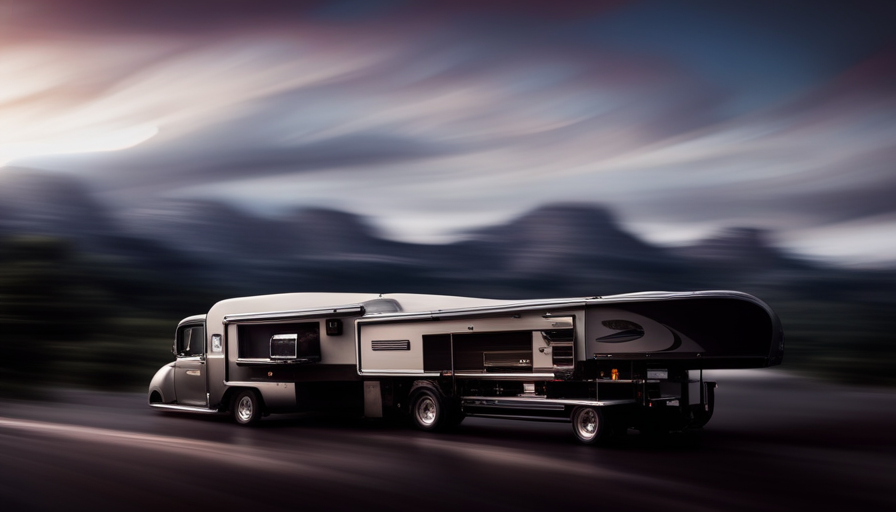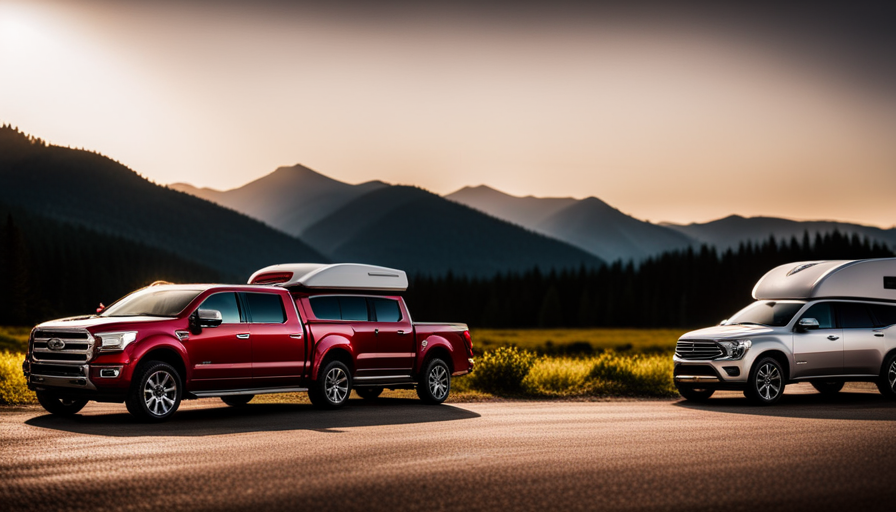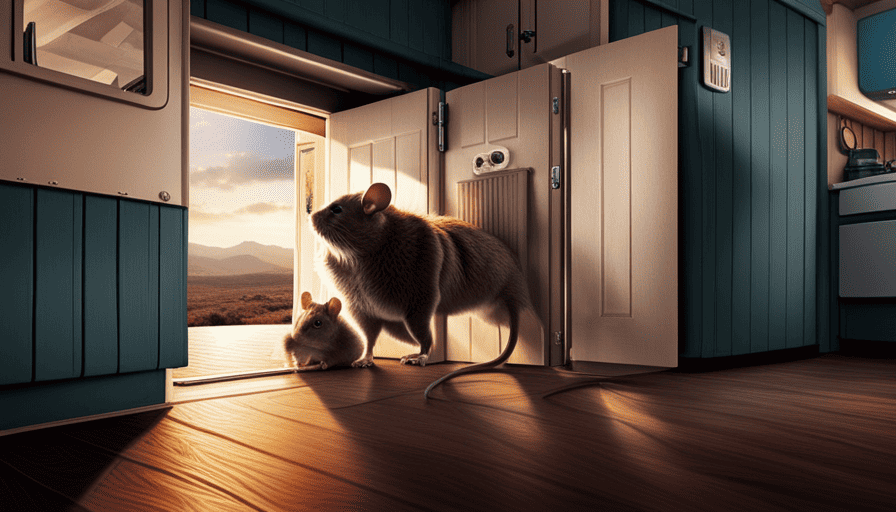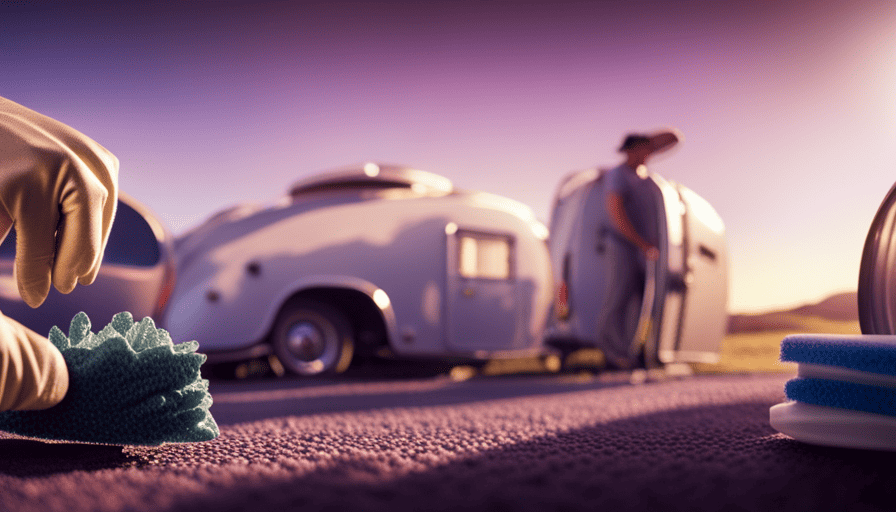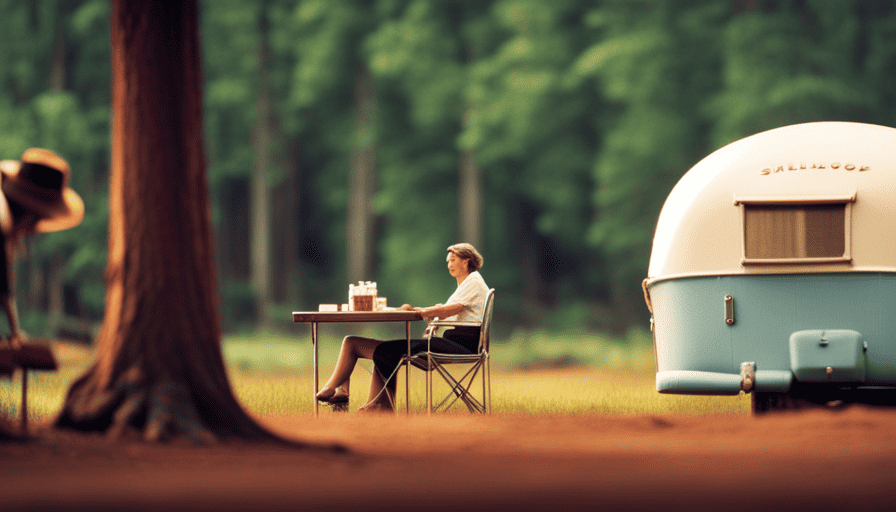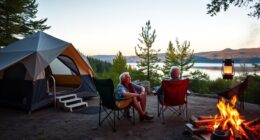Imagine this scenario: you’re journeying along the highway, feeling the breeze through your hair and embracing the liberty that the wide, open spaces offer. Now, consider elevating your camping experiences. Welcome to the realm of truck campers – the ultimate blend of convenience and coziness.
Now, before you hit the road, you’ll need to find the perfect truck to match your camper. But with so many options out there, where do you even begin? Don’t worry, we’ve got you covered.
In this article, we’ll guide you through the process of choosing the right truck for your truck camper. From considering weight and size to assessing towing capacity, engine power, and safety features, we’ll break it all down for you. So buckle up and get ready to find the perfect truck for your ultimate camping experience.
Key Takeaways
- Choosing the right truck for a truck camper involves considering weight, size, towing capacity, engine power, and safety features.
- Exceeding the payload capacity can lead to poor handling, increased wear and tear, and safety hazards.
- Choosing a truck with towing capacity that exceeds the camper’s weight ensures safe and stable towing.
- Assessing towing capacity involves considering engine power, transmission, suspension, and braking systems.
Consider the Weight and Size of Your Camper
You’ll need to carefully consider the weight and size of your camper when choosing the right truck for it, as this will greatly impact your overall driving experience and safety on the road.
One of the key factors to take into account is the truck’s payload capacity. Payload capacity refers to the maximum weight that the truck can carry in its bed, including the weight of the camper itself and any additional gear or supplies. It is essential to ensure that the truck’s payload capacity is sufficient to handle the weight of your camper, as exceeding this limit can lead to poor handling, increased wear and tear on the vehicle, and potential safety hazards.
Another important consideration is the towing capacity of the truck. Towing capacity refers to the maximum weight that the truck can tow, which includes the weight of the camper and any additional trailers or vehicles being towed. It is crucial to choose a truck with a towing capacity that exceeds the weight of your camper, ensuring that it can handle the load without straining the engine or compromising the vehicle’s stability.
To determine your payload capacity needs, you should calculate the weight of your camper, including any additional gear and supplies you plan to carry. This will allow you to select a truck with a payload capacity that comfortably accommodates the total weight.
By carefully considering the weight and size of your camper, as well as the truck’s payload and towing capacities, you can ensure a safe and enjoyable driving experience for your truck camper adventures.
Determine Your Payload Capacity Needs
With all the gear and supplies you want to bring on your road adventures, it’s crucial to figure out how much weight your trusty ride can handle. Determining your payload capacity needs is an essential step in choosing the right truck for your truck camper.
To do this, you need to assess your storage needs and consider the weight of all the items you plan to bring along. This includes not only your camping gear but also food, water, and any other supplies you might require during your trip.
In addition to determining your storage needs, it’s important to assess the off-road capabilities of the truck. If you plan to venture off the beaten path and explore remote areas, you’ll want a truck that can handle rough terrain and provide a smooth and stable ride. Look for trucks with features like four-wheel drive, sturdy suspension systems, and high ground clearance.
By determining your payload capacity needs and assessing the off-road capabilities of different trucks, you can narrow down your options and find the perfect truck for your truck camper. Once you have a good understanding of these factors, you can move on to the next step of the process: assessing the towing capacity of different trucks.
Assess the Towing Capacity of Different Trucks
Once you’ve determined your payload needs and evaluated the off-road capabilities, it’s time to explore the towing capacity of various trucks and envision the thrill of effortlessly pulling your camper through diverse landscapes.
Assessing the towing capacity is crucial as it determines the weight your truck can safely tow, ensuring a smooth and secure journey. When comparing truck options, consider the following:
-
Engine Power: A truck with a powerful engine will have higher towing capacity. Look for trucks that boast impressive horsepower and torque to handle the weight of your camper.
-
Transmission: Opt for a truck with a transmission specifically designed for towing. Automatic transmissions with towing modes offer better control and efficiency when hauling heavy loads.
-
Suspension and Braking Systems: A truck with a robust suspension system and advanced braking technology will provide stability and control while towing, ensuring your safety on the road.
Considering these factors will help you make an informed decision when selecting the right truck for your camper. As you assess the towing capacity of different trucks, you’ll gain a better understanding of which options align with your needs and preferences.
In the subsequent section, we will explore how to choose between a half-ton or heavy-duty truck, taking into account their respective capabilities and features.
Choose Between a Half-Ton or Heavy-Duty Truck
When it comes to deciding between a half-ton or heavy-duty truck, it’s important to consider their respective capabilities and features. Both options have their own set of pros and cons, so it’s crucial to evaluate your specific needs and preferences.
A half-ton truck, also known as a light-duty truck, is generally more affordable and fuel-efficient compared to a heavy-duty truck. It offers a smoother ride and better maneuverability, making it suitable for everyday use and city driving. However, its towing and payload capacities are lower than that of a heavy-duty truck, limiting its ability to handle larger and heavier loads.
On the other hand, heavy-duty trucks are designed for heavy hauling and towing. They have a higher towing and payload capacity, making them ideal for towing large trailers or carrying heavy equipment. Heavy-duty trucks also tend to have more powerful engines, allowing them to handle demanding tasks with ease. However, they are bulkier and less fuel-efficient than half-ton trucks, and their larger size can make them less agile off-road.
When considering the off-road capabilities of half-ton vs heavy-duty trucks, it’s important to note that heavy-duty trucks usually have better off-road performance due to their larger size, higher ground clearance, and more robust suspension systems. However, advancements in technology have allowed half-ton trucks to improve their off-road capabilities, making them a viable option for off-road enthusiasts.
The decision between a half-ton or heavy-duty truck ultimately depends on your specific needs and preferences. If you require more towing and payload capacity, along with better off-road performance, a heavy-duty truck may be the better choice. However, if you prioritize affordability, fuel efficiency, and maneuverability, a half-ton truck might be more suitable. Consider the engine power and fuel efficiency when making your decision.
Consider the Engine Power and Fuel Efficiency
To make the best choice for your needs, you should carefully consider the engine power and fuel efficiency of the options available to you. When it comes to engine power, you want to ensure that your truck has enough horsepower and torque to handle the weight of your truck camper. This will ensure a smooth and powerful driving experience, especially when towing or going uphill.
Additionally, fuel efficiency is an important factor to consider, as it will directly impact your overall cost of ownership. A truck with good fuel efficiency will not only save you money at the pump but also reduce your environmental impact.
Here are three key points to keep in mind when evaluating the engine power and fuel efficiency of a truck for your truck camper:
-
Engine Power: Look for a truck with a powerful engine that can handle the weight of your camper. This will ensure that you have enough power for towing and going off-road if needed.
-
Fuel Efficiency: Consider a truck with good fuel efficiency to reduce your overall cost of ownership. Look for models with fuel-saving technologies such as direct fuel injection and cylinder deactivation.
-
Cargo Space: Don’t forget to consider the cargo space available in the truck bed. You’ll want to ensure that there is enough room for your camping gear and other essentials.
By carefully evaluating the engine power and fuel efficiency of the trucks you are considering, you can ensure that you choose a truck that meets your needs and provides a comfortable and efficient camping experience. As you move on to evaluate the suspension and handling of the truck, you’ll be one step closer to finding the perfect truck for your truck camper.
Evaluate the Suspension and Handling of the Truck
Now, imagine ourselves cruising down a winding mountain road, feeling the smooth suspension absorb every bump and curve, providing us with a comfortable and controlled driving experience.
When evaluating the suspension and handling of a truck for a truck camper, it’s essential to consider the ride quality and how it contributes to overall comfort and stability. A well-designed suspension system will ensure that the truck can handle the weight of the camper without compromising on handling or ride comfort.
To evaluate the ride quality, it’s important to test drive the truck with the camper attached. This will give us a firsthand experience of how the suspension performs under load. We should pay attention to how the truck handles corners, accelerates, and brakes. A smooth and controlled ride will enhance our overall driving experience, especially on uneven or bumpy terrains.
Furthermore, researching the maintenance costs of the truck is crucial. Some trucks may require more frequent maintenance or have higher repair costs. By researching this aspect, we can ensure that we choose a truck with a reliable and cost-effective maintenance schedule, reducing the chances of unexpected expenses down the road.
Considering the suspension and maintenance costs are essential steps in finding the perfect truck for a truck camper. However, it’s also important to research the safety features and technology that the truck offers. By doing so, we can ensure that our journey is not only comfortable but also safe.
Research the Safety Features and Technology
Imagine cruising down a winding mountain road, feeling the smooth suspension absorb every bump and curve, while the advanced safety features and technology of the vehicle keep you and your passengers safe.
When researching truck camper safety, it’s essential to consider the advancements in truck technology. Here are four key points to keep in mind:
-
Collision avoidance systems: Many trucks now come equipped with sophisticated sensors and cameras that can detect potential collisions and alert the driver. These systems can even apply the brakes autonomously to prevent accidents.
-
Adaptive cruise control: This feature not only maintains a set speed but also adjusts the vehicle’s speed to match the flow of traffic. It can help reduce driver fatigue and improve overall safety.
-
Blind spot monitoring: With large blind spots, trucks can be challenging to maneuver. Blind spot monitoring systems use sensors to detect vehicles in the truck’s blind spots and provide visual or audible warnings to the driver.
-
Lane departure warning: This technology uses cameras or sensors to monitor the truck’s position within the lane. If the truck starts to drift out of its lane, the system alerts the driver, preventing potential accidents.
By researching these safety features and advancements in truck technology, you can ensure a safer and more enjoyable journey.
Now, let’s explore the next important aspect: looking into the interior space and comfort.
Look into the Interior Space and Comfort
After thoroughly researching the safety features and technology of various trucks, it’s now time to delve into the interior space and comfort. This is a crucial aspect to consider when selecting the perfect truck for your truck camper.
The interior design and ergonomic features of the truck can greatly impact your overall comfort and enjoyment during your travels. When it comes to interior design, you want to look for a truck that offers ample space for both you and your passengers. Consider the layout of the cabin, the seating configuration, and the storage options available.
A well-designed interior will provide you with the necessary space to relax and unwind after a long day on the road. In addition to space, ergonomic features are equally important. Look for trucks that prioritize comfort and convenience. Features such as adjustable seats, easy-to-reach controls, and intuitive infotainment systems can greatly enhance your driving experience.
Taking the time to evaluate the interior space and comfort of potential trucks will ensure that you find a vehicle that meets your needs and preferences. With this in mind, let’s now shift our focus to the next step: considering the brand reputation and reliability of the truck.
Consider the Brand Reputation and Reliability
When considering which truck to choose for your truck camper, it’s crucial to take into account the brand’s reputation and reliability. This is especially important because you want a truck that can handle the weight and demands of a camper. Here are some key points to consider:
-
Brand reputation: Look for a brand that has a strong reputation in the truck industry. This indicates that they’ve got a track record of producing reliable and durable vehicles. Brands like Ford, Chevrolet, and Ram are well-known for their trucks and have a reputation for quality.
-
Reliability: Consider the reliability of the truck model you’re interested in. Look for reviews and ratings from other truck owners to get an idea of how reliable the truck is over time. You want a truck that can handle the demands of towing a camper without constant breakdowns or maintenance issues.
-
Camper weight: Make sure the truck you choose can handle the weight of your specific truck camper. Different campers have different weights, so it’s important to check the truck’s towing capacity and payload capacity. You don’t want to exceed these limits and risk damaging your truck or compromising safety.
Considering the brand’s reputation and reliability is essential when choosing a truck for your truck camper. Once you’ve narrowed down your options, the next step is to set a budget and compare prices for the trucks that meet your requirements.
Set a Budget and Compare Prices
Once you’ve considered the brand reputation and reliability, it’s time to buckle down and establish a budget, comparing prices to ensure you find the best deal.
Setting a budget is crucial when it comes to purchasing a truck for your truck camper. It helps you determine how much you can afford and narrows down your options. Begin by evaluating your financial situation and determining how much you can comfortably spend on a truck. Consider factors such as your income, expenses, and any other financial obligations you may have.
After setting a budget, it’s important to compare prices. Research different truck models and their prices to get an idea of what you can expect to pay. Visit dealerships or check online listings to see what trucks are available in your price range. Take note of any features or options you may want in your truck camper and consider their costs as well.
Additionally, it’s a good idea to set a timeline for your purchase. Determine when you need the truck camper and work backward to establish a timeline for finding and purchasing a truck. This will help you stay organized and focused during the process.
Lastly, don’t forget to research financing options. If you plan on financing your truck purchase, compare interest rates and loan terms from different lenders to ensure you get the best deal. This will help you secure the necessary funds for your truck purchase while staying within your budget.
Frequently Asked Questions
What are some important safety features to look for in a truck when choosing a truck camper?
When choosing a truck camper, it’s important to consider safety features that align with your payload capacity and interior space requirements. Key features to look for include a sturdy frame and suspension system to handle the additional weight of the camper. Additionally, advanced braking systems and stability control are important for enhanced control and stopping power. Features like backup cameras and blind spot monitoring can help improve visibility and reduce the risk of accidents.
How do I determine the payload capacity I would need for my truck camper?
To determine the payload capacity needed for a truck camper, you must conduct a payload capacity calculation and weight distribution analysis. The calculation involves adding up the weights of the camper, occupants, and any additional cargo. It’s important to consider not only the weight of the camper itself but also the weight distribution to ensure proper balance and stability. Conducting these analyses will help determine the appropriate payload capacity required for a specific truck camper setup.
Are there any specific brands of trucks that are known for their reliability when it comes to towing truck campers?
When it comes to towing truck campers, there are several truck brands that have a reputation for reliability. To determine this, one can look at reliability rankings and performance comparisons.
These rankings take into account factors such as engine power, towing capacity, and overall durability. While there are no specific brands that consistently top these rankings, some popular choices known for their reliability include Ford, Chevrolet, and Ram.
Ultimately, it’s important to research and compare different models to find the best fit for your specific needs.
What are some key factors to consider in terms of interior space and comfort when choosing a truck for a truck camper?
When considering interior space and comfort for a truck camper, it’s crucial to focus on two key factors:
-
Interior design: The interior design should prioritize functionality and efficiency, with ample storage and living space.
-
Mattress quality: A comfortable and supportive mattress is essential for a good night’s sleep on the road.
By carefully considering these factors, you can ensure a cozy and enjoyable living space in your truck camper.
How do I assess the suspension and handling of different trucks to ensure a smooth and stable ride with a truck camper?
Assessing the suspension and handling of different trucks is crucial for ensuring a smooth and stable ride with a truck camper. To evaluate suspension, consider factors such as the type (leaf springs or air suspension) and its ability to absorb bumps.
Handling can be assessed through test drives, looking for responsiveness and stability. Additionally, prioritize safety features like stability control and anti-lock brakes.
It’s also important to consider the truck’s payload capacity and choose reliable truck brands known for their durability. These factors, along with interior space and comfort, contribute to a pleasant truck camper ride quality.
Conclusion
After carefully considering the weight and size of your camper and determining your payload capacity needs, assessing the towing capacity of different trucks, and choosing between a half-ton or heavy-duty truck, it’s time to make a decision. But before we unveil the ultimate truck for your truck camper, let’s take a moment to recap the important factors to consider.
Stay tuned for the big reveal!

